Udupi - city in Karnataka, India
Most Indians know of Udupi not as a place, but as a category of restaurants. Udupi restaurants that generally serve vegetarian food in the South Indian style can be found all over India. Not many know of the sleepy coastal town from which this great cuisine originated, Still fewer know of its reputation as the location of a Krishna temple and a monastery established by the founder of one of the three main philosophical strains of present-day Hinduism.
Many, however, have heard of Manipal, a major educational centre, and a suburb of Udupi, that attracts students from all over India and internationally.
The town of Udupi lies in Udupi taluka which in turn is in Udupi district. This article covers the taluka. To its north is Kundapura and to its west is Karkala, at the foothills of the Western Ghats. To the south of Udupi is Mangalore, which is the headquarters of the Dakshina Kannada district.
Understand
History
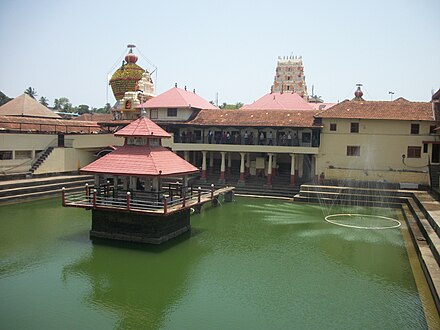
Its claim to fame is as a religious and spiritual centre. Udupi is the headquarters of the Maadhva sect of Hinduism. This sect was established by the sage Madhvacharya in the 13th century. He propounded the Dvaita philosophy, which is commonly translated as dualism, rivaling the older Advaita (non-dualism) philosophy propounded by Sankaracharya,
Maadhvas are Vaishnavites, worshippers of Vishnu, of whose many incarnations Krishna is one. The Krishna temple Madhvacharya worshipped at is the heart of the city, and a major pilgrimage destination.
Udupi had a nascent career as a financial hub till the 1960s, with many banks being established here, but most of them got nationalized. Manipal, a suburb of Udupi city, is an important educational and medical centre owing to the efforts of T M A Pai in the 1960s.
Climate
The weather is fairly equable throughout the year, due to the nearby Arabian sea. Temperature ranges from 30 to 35 °C in day time and is around 25 °C at night. Humidity is normally high most of the time.
The rainy season is from June to September. At this time the monsoon shows its colours. Within seconds, you could find yourself soaked in rain water.
The best time to visit is October to March, when the weather is cool. April and May will be hot and June to September will be wet, so if you are visiting during this time, you will spend most of your time indoors. But then, April and May is when you get the ripe mangoes, and June to September is when the rains make the area green and beautiful, so life isn't fair.
Get in
Udupi is well-connected with the cities on India's west coast. NH-66 (formerly NH-17) runs right through Udupi, connecting it to Mumbai and Goa to the North and Mangalore and Kochi to the South. Konkan Railway connects Udupi to the same cities. The city is around 406 km from Bangalore, the capital of Karnataka. Rail connectivity with Bangalore is good, but travelling by road is a good option, as you are exposed to the beauty of the nature. The road journey through Agumbe ghats is really mesmerizing.
By plane
Mangalore International Airport (IATA: IXE) is 59 km from Udupi. The airport is well-connected with major Indian cities and a few Middle-eastern destinations.
Pre-paid taxis (non air-conditioned) can be booked from the counter inside the arrival terminal. They take approximately 1½ hours to reach.
Goa's Dabolim airport (IATA: GOI) is around 300 km from Udupi. Getting in via Goa is not the most practical or convenient way to get to Udupi, but if you are planning to combine a vacation in Goa, this is a good option.
By train
Udupi is a major station on the Konkan railway route. There are connections with Mumbai, Bangalore and Mangalore. Major trains including Rajdhani Express stop at Udupi Railway Station. A night train is available from Mangalore to Bangalore, known as the Mangalore-Bangalore express. Yeshwantpur-Karwar express is another train which connects Bangalore to Udupi and runs on Monday, Wednesday and Friday.
By car
Udupi is located right on National Highway NH-66 (formerly NH-17) connecting Kochi with Mumbai. See Karavali#Get in about the lowdown on this route. This connects Udupi with Kerala, Coastal Karnataka (including Mangalore), Goa, and the Konkan region of Maharashtra. Drive in on your own only if you are used to driving on Indian highways. Alternatively, hire a driver or take a cab.
From Bangalore, you first must come to Mangalore via roads which mostly pass through zig-zag hilly roads, or ghats. NH-75 (formerly NH-48) is the road that connects Bangalore and Mangalore, which passes through Shiradi Ghat. However, the ghat roads seem to get damaged every year during the monsoon, so make inquiries in advance and decide which of the four ghats is relatively passable and adjust that portion of the route accordingly.
By bus
Buses regularly ply from major southern cities and Maharashtra to Udupi. Choose from the Volvos (AC buses), Airbuses or KSRTC buses depending on your budget. Private buses generally have two stops in Udupi — the service bus stand at the centre of the city, and near Tiger circle at Manipal. It is one-hour journey from Mangalore (around 60 km). Regular buses ply from Mangalore very frequently, both AC and non-AC. You will easily get those from either Mangalore KSRTC bus stand or from the public bus stand (locally called the State Bank bus stand). It is also well connected from nearby towns like Murudeshwar, Karwar or Gokarna.
Get around
Buses, cabs and auto-rickshaws are ways to get around the city. Udupi has excellent city bus services run by various private companies. Buses generally start and end at the main bus stand. There are bus stops throughout the city. Ask around. Tickets can be bought once you board or from the conductor just before boarding. Rates start from ₹5 per 2 km.
By taxi
Hired cabs are available, though they can't be hailed off the street. They are unmetered, but as a general guide, ₹15 per kilometer for an non-airconditioned compact car for short distances is a good starting point.
By autorickshaw
Autorickshaws can be found on the street, and are generally a cheap mode to travel. For autos, fares start at ₹25 for the first 1.5 km and go up by ₹16 every kilometer after that. This is assuming that they agree to go by the meter, which they generally do not. Nonetheless, this is a good guide to estimate the rate you should agree to.
On foot
Walking around the city when the weather is good is a nice experience. There aren't any footpaths, though, so you will have to share the side of the road with autos and bikes.
See
Udupi has some nice beaches, lush greenery, the quaint charm of a small town and many temples. Many of the places to visit are not very well known to many people outside of Udupi. If you are an adventurous person who loves nature, there is a lot to explore in Udupi.
Krishna temple complex
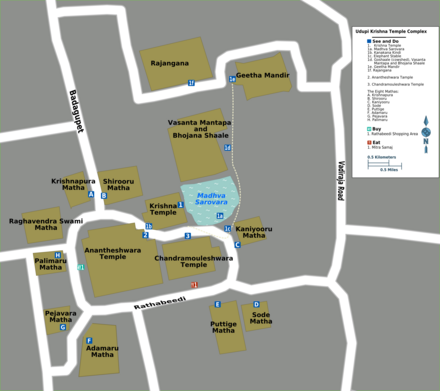 The heart of Udupi is undoubtedly the Krishna temple complex. It comprises of, in addition to the main temple, two other historic temples - Anantheshwara and Chandramouleshwara, all connected by the Ratha beedi or "chariot street", so called because on festive occasions such as the "Paryaya", the deity is taken in procession in temple chariots. The chariots themselves are usually stationed at Ratha beedi.
The heart of Udupi is undoubtedly the Krishna temple complex. It comprises of, in addition to the main temple, two other historic temples - Anantheshwara and Chandramouleshwara, all connected by the Ratha beedi or "chariot street", so called because on festive occasions such as the "Paryaya", the deity is taken in procession in temple chariots. The chariots themselves are usually stationed at Ratha beedi.
In addition to propounding a philosophy and performing miracles, Madhvacharya also established a monastic order with eight main monasteries (or "mutts"). All around the Ratha beedi are the eight mutts (ashtamathas).
20th century additions to the area are the Gita Mandira and the Rajangana, where cultural programmes and discourses held, a short walk away. The Ratha Beedi is also a shopping street.
How the Krishna idol came to be
While the temple is over 1500 years old, it came into prominence due to Madhvacharya who is also credited with installing the current idol. Legend has it that Madhvacharya used his divine powers to save a ship that was in the thick of a storm. The ship happened to have set sail from Dwaraka, the legendary home of Krishna, and was carrying an idol of him. The captain of the ship, in gratitude, gifted the idol to his saviour, who then went on to install it in the Krishna temple.
-
Sri Krishna Temple and Mutt, Ratha Beedi (Chariot Street), 13.34112°, 74.75201°, +91 820-252 0598. 5AM-9:30PM. A complex of temples and monasteries located near the Madhva Sarovara, or Madhvacharya's pond.
The main temple is constructed in the architectural style typical in Kerala and Dakshina Kannada, with multiple layers around the inner sanctum sanctorum, with no massive sikhara over it as is found elsewhere in South India. There are shrines to subordinate deities including Garuda and Hanuman. On special occasions, the temple area is beautifully decorated with flowers and lamps.
Offerings can be made and "prasadam" can be bought inside. The temple offers free lunch to everyone at three dining halls, or Bhojana Shaalas.
Free 2018-08-02 -
Kanakana Kindi (Kanaka's Window), Ratha Beedi, 13.34129°, 74.75180°. 24 hrs. The unusual feature of Udupi's Krishna temple is that the statue faces west, and away from the devotees. To catch a glimpse of the deity, you need to make your way to Kanaka's window. The reason for this, apparently, is that a lower-caste devotee named Kanakadasa was denied entry into the temple, so he tried worshiping from a small window outside it. The Lord was so pleased at his devotion that He turned around to face the window. The window is now named after him, and a massive Gopura (or tower) has since been built over it. Free 2020-12-04
-
Madhva Sarovara, 13.34133°, 74.75232°. Madhva Sarovara is right next to the temple and is accessible from both inside and outside of it. has a "mantapa" or canopy at its centre, and the pond is often beautifully lit. A bath at the sarovara may or may not be possible. Inquire before taking the plunge. 2020-12-04
-
Anantheshwara temple, 13.34102°, 74.75177°. This is a temple dedicated to Parashurama, another incarnation of Vishnu, and according to legend, the creator of the landmass encompassing Udupi, Dakshina Kannada and Kerala. The temple dates back to the 8th century. 2020-12-04
-
Chandramouleshwara temple, 13.34080°, 74.75215°. Right next to the Krishna temple is this temple dedicated to Shiva, to whom, according to legend, the moon (Chandra) prayed at this spot. 2020-12-04
Other attractions

- Malpe beach, SH65, near Stella Maris Church, 13.3565°, 74.7015°. Visit Malpe beach where you can take fantastic pictures of the sunset in the background of St Mary's island. Nice clean beach, not inundated by tourists. Free 2020-12-21
- Manipal End-point Park, SH65, Manipal, 13.3701°, 74.7858°. A small cliff that overlooks the Suwarna river. From this point, you can get a beautiful view of the sea as well as the mountains. Very popular with Manipal University students. Free
- Pajaka Kshetra, Kunjarugiri (around 10 km from the city centre), 13.2715°, 74.7921°, +91 820-255 9013, +91 820-200 9013, +91 94489 52913. The birthplace of Madhvacharya, considered a holy place by believers. Has a temple dedicated to Durga, a memorial dedicated to Madhvacharya and some ponds, bathing in which supposedly cleanses one of all sins. Free
- St Mary's Island, Off Malpe Beach (boats are available from Malpe Beach), 13.3808°, 74.6722°. 8:30AM to 4:30PM. Rock formations created by a mixture of volcanic lava flow and waves. Legend has it that the Portuguese explorer Vasco Da Gama landed here and claimed the island in the name of Mother Mary. The island also has a beautiful beach which is worth visiting. The first boat is supposed to run at 8:30AM, last boat to that island is around 4:30PM and from that island is 6PM. The boat leaves only if there are around 30 visitors. Waiting time may be about 30 minutes for tourists to arrive before the boat leaves. It is best to do this in the evening or early mornings. If visiting during noon, there is little shade to be found. Food and drinks are sold on the island. About ₹300 for the return ticket 2020-12-17
- Udyavar Pithrodi, Udyavar (3 km from Udupi town. Take a boat to Pithrodi island), 13.2971°, 74.7196°. This is an island at the mouth of a river that is near Udyavar beach. Within 100 meters of the sea, you get an amazing view at the island. Beware of pollution from the nearby fishing mills though. Boatman may charge around ₹10 per person
Do
Udupi has some great beaches, but thankfully, they aren't big water sports destinations like Goa, though there are some options. If you are the adventurous sort, you can head south to Mulki, Mangalore where the Ashram surf retreat combines surfing with spiritualism.
If the mountains are what you are after, turn east to Karkala, where Agumbe and other places provide some excellent trekking opportunities.
For a cultural experience, try to catch a performance of Yakshagana, a Bhoota Kola or a Naga Mandala. The latter two are essentially religious rituals, but a sight to watch. The Yakshagana is a genre of dance-drama that is native to the Karavali region. The performances are advertised only in local Kannada newspapers, so it might be somewhat difficult to catch them. Also, to fully appreciate Yakshagana, you need to understand Kannada or Tulu.
-
Paryaya. Madhvacharya decreed that after he passed on, the heads of the eight mutts and their successors would head the main Udupi mutt in rotation for two months each. One of his notable later day successors, Vadiraja of Sode Matha, who lived during the 16th century, changed the tenure from two months to two years. This practice, called Paryaya continues to this day. The handover to the new head of Udupi mutt happens on 18 January on even numbered years, and is an occasion for much celebration and many religious ceremonies. 2020-12-08
-
Stay at a Houseboat, Paradise Isle Beach Resort Pvt. Ltd., Malpe Beach, 13.3605°, 74.6989°, +91 820-253 8777, +91 820-253 8666, resort@theparadiseisle.com. The trip takes you to Paradise Lagoon. Package includes all meals. It is not clear if packages of shorter duration are available - call to ask. The resort also offers normal rooms, and has some options for water sports as well. ₹14,000 for 2 nights, 3 days
-
Seethanadi Nature Camp, Hebri Karkala Taluk (36 km east of Udupi on NH169A, a few kilometres beyond Hebri village), 13.4714°, 75.0188°, +91 94495 99758. Whitewater rafting during monsoon season. Best time of visit is from July to late January. This rustic resort offers accommodations and activities. 2023-02-14
Buy
 While Udupi, like any other city of moderate size, offers many opportunities to shop, and the Ratha Beedi area around the temple is a popular and interesting destination to buy what the city is best known for. Most people who visit the temple combine their religious sojourn with a shopping expedition. On festive occasions, the area around the Krishna temple comes abuzz with many temporary shops set up for the occasion.
While Udupi, like any other city of moderate size, offers many opportunities to shop, and the Ratha Beedi area around the temple is a popular and interesting destination to buy what the city is best known for. Most people who visit the temple combine their religious sojourn with a shopping expedition. On festive occasions, the area around the Krishna temple comes abuzz with many temporary shops set up for the occasion.
Befitting Udupi's status as a culinary paradise, many of the items on the must-shop list at Ratha Beedi are culinary. Snacks and juice extracts top the list. Spices and oils used in traditional Udupi cooking can also be bought here. Shops that sell vessels and other implements used to prepare Udupi-style cuisine are scattered all over the street. Among these are aluminium pans to make guliyappa and the aruvamane used to scrape coconuts.
Other items to look out for are wood handicraft items such as agarbatti stands, idols of deities, and altars. This is also a good place to buy Ayurvedic medicines and massage oils.
- Saaru powder (Saarina Hudi), Sambhar powder part of world famous Udupi cuisine and Coconut oil.
- Pickles made from Mango, Lemon and different vegetables.
- Cotton wicks (Bathi) used to light lamp in front of Gods, Incense sticks (Udinabathi) and other Pooja /Japa/ Homa /Havan related items at Car street (Ratha beedi) near to Krishna Matha at Udupi city.
- Happala (Pappad) and Sandige made from Black gram (Uddu), Horse gram (Huruli), Sweet potato (Genasu) and Jack fruit (Halasina hannu).
- Sweets and savouries
Clothing, particularly silk sarees but also other traditional Indian and western dresses, and jewellery are the other two big items that are on many visitors' shopping lists in Udupi.
Clothing
For your saree/dress purchases:
- Kalsanka Girija Silk, Badagupet, 13.3421°, 74.7511°, +91 820-2522810. For Kanchipuram, Dharmavaram, Banaras silk sarees.
- Sai Ram Textorium, Opp. Sanskrit College, 13.3320°, 74.7459°, +91 824-252 0930. Good shop for various kinds of dress materials.
Jewellery
Udupi is famous for traditional jewellery. Famous jewellers are:
- Abharan, Corporation Bank Rd, 13.3436°, 74.7500°, +91 820 4297777, +91 820 2521267, info@abharan.com. 10:30AM-6:30PM. Offers a wide variety of jewellery
- Bhima Jewellers, 110 B, Maruti Veethika, Chitharanjan Circle, 13.3396°, 74.7499°, +91 820-259 3112. Jewellery showroom
- Swarna, Shankar Building, Mosque Rd, 13.3458°, 74.7545°, +91 825 23655. This is one of the go-to shops for traditional Indian jewellery.
Snacks and packaged food
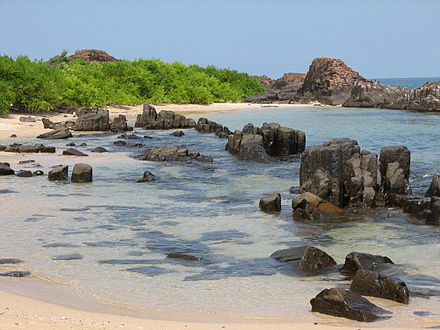
- Alwyn Bakery, Vidyarathna Building, Near Bus Stand, 13.3413°, 74.7477°, +91 820-252 3051, +91 98451 17845. Conveniently located, if you need to buy something in a hurry before setting off in a bus.
- New Diana Stores, Diana Circle, opposite Syndicate Bank Towers, 13.3369°, 74.7493°, +91 820-252 0019. This is good place to buy packaged foodstuffs.
General purchases
- Big Bazaar, Plot No. 88, 5D 6A, Opp. T.M.A Pai Hospital, Near Taluka Office, 13.3317°, 74.7472°, +91 820-429 8888. A symbol of Udupi's modernization. The store is 40,000 sq ft in area and is equipped with escalators. Very popular and very crowded.
- Little Pai Super store, City Camp Building, Near Geethanjali Theatre, Vidyasamudra, 13.3435°, 74.7505°, +91 820-252 3975, +91 820-429 5975.
- Nilgiri's, Himalaya Pearl, Udupi Manipal Main Road Kadiyali Kunjipettu Post, 13.3458°, 74.7560°, +91 820-429 6239. Another of the supermarkets where you can supposedly buy everything. Nilgiri's is an over 100-year old brand, though the store is more recent. 2020-12-04
- Sampoorna Departmental Store, Ratha Beedi, 13.3406°, 74.7518°, +91 820-252 3957.
Eat
Udupi cuisine
See also: South Asian cuisine
The story of Matti Gulla
Vadiraja Swamy, a 16th century successor of Madhvacharya, was a great devotee of Hayagreeva, the deity that is reputed to be an Avatar of Vishnu in the form of a horse. He also had rivals who once tried to poison his food. But because he always offered his food to his god before consuming it, they effectively ended up offering poison to the deity. When said rivals realized their folly, they rushed to Vadiraja and asked for forgiveness and asked how they could make amends. Vadiraja, through his supernatural powers, gave them a few seeds of eggplant and asked them to plant them in Matti, a village near Udupi. The resulting variety of eggplant would be free of all "poison" - i.e. it would have a mild taste and be easy on the stomach. To this day, the variety of eggplant grown in Matti, known as Matti Gulla, is famous for these properties.
The vegetarian cuisine of Udupi is famous all over India and among Indians abroad. For this reputation, it must thank the Sri Krishna temple and its traditions. The temple offers free food to everyone who wants to partake of it. The cooks have traditionally been the Brahmins belonging to the Shivalli sect, who, over the centuries, have perfected the art of cooking that adheres to "Satvik" principles. This requires not just vegetarianism but also the avoidance of onion and garlic, as these are said to excite the baser senses. In spite of these limitations, the food of Udupi tastes great, with subtle flavours.
While the eat section of the Karavali article more than adequately covers the cuisine you are likely to encounter here, Udupi has some items of food that are unique to the place. One of them is the matti gulla (see infobox) a variant of eggplant. Ibbulle, a kind of musk melon is a speciality here. The best way to consume it is by turning it into rasayana, a kind of thick, pulpy juice. Ibbulle is such a localized fruit that there are people who've lived in Mangalore all their lives and have never heard of the fruit. Then there is hayagreeva maddi a sweet made of chickpea, coconut and jaggery that is offered as prasadam to Hayagreeva (see infobox). Golibaje, a traditional fried snack item made from maida (all-purpose flour) and yoghurt, is another speciality of Udupi. Also, try out the "charmuri upkari", a famous snack from the handcarts around Rathabeedi. The ginger soda is a famous drink available in many local shops.
Meat-eaters will not be disappointed in Udupi either. Do not forget to try the famous non-veg dishes kori sukha (chicken in spicy masala with grated coconut), kori rotti (chicken curry with crisp rice roti). Seafood here is great as well. Some common local fish are bangude fish and king fish. Definitely try the bangude tawa fry or the fish thali which is available at many restaurants__.__
At Malpe beach, visit the fish fry shop just outside the beach. Prices start from Rs 30. .
If you are looking for international cuisines, Manipal is the place to go to.
Budget
Udupi restaurants
Udupi restaurants are not just found in Udupi. Starting from the middle of the 20th century, many people from Udupi (and the Karavali region in general) migrated to Mumbai for better career opportunities. Often, the migrants were bachelors who naturally craved food from back home, and a significant number were Brahmins who would not let go of caste related taboos against eating food cooked by non-Brahmins. The Udupi restaurants came up in Mumbai to cater to this group of people. Very soon, these eateries, serving cheap, nutritious and vegetarian food became very popular and spread all over India. However, very few of these restaurants have stayed true to their roots - and today, you are likely to find the usual South Indian-North Indian-Chinese cuisines in those restaurants.
- 7 Bees Cafe, Opp. Mother Of Sorrows Church, K. M. Marg, 13.3372°, 74.7492°, +91 820-429 3323, +91 98864 62007, +91 98867 40888. A famous fast food restaurant.
- Basil Cafe, Princess Kirthi, Behind Manipal Edu Building, Manipal, 13.3541°, 74.7842°, +91 820-429 3284. 11:30AM-11:30PM. Hangout place with a stylish ambience. Indian, Mexican and Italian.
- Campus Veg treat, within Summer Park hotel complex near Gitanjali theatre, 13.3443°, 74.7510°. This is a multi-cuisine vegetarian restaurant. Try the Mushroom Handi Biryani.
- Diana, Canara Mutual Building, Diana Circle (opposite the Fish Market), 13.3360°, 74.7494°, +91 820-2520505, +91 820-2522586. A 60-year-old institution for 'fast food" Indian-style; the 'Channa Pathora', 'Banana Bonda' and 'Veg Noodles' are favourites. The Veg cutlets here also are yummy. In the weekends, this restaurant is packed with college students. Being situated at a busy junction affords good view of the bustle outside, especially when seen from the first floor section. Not to forget the famous "Gadbad" ice cream served at Diana's.
- Dollops, Near State Bank of India, Tiger Circle, Manipal, 13.3518°, 74.7874°, +91 820-257 0908. 11:30AM-11PM. A small eatery popular with students. Good food at cheap prices. Serves both vegetarian and non-vegetarian items
- Kushi, Santhekatte, on NH66 (near Robosoft Technologies). One of Udupi's most famous vegetarian restaurants, has been in existence for over 20 years. Also has an ice cream parlour. You can sample authentic Udupi dishes like 'Goli Bhaje, 'Masala Dosa' ,'Idli Vada Sambar' with the special Coconut Chutney. You can also try the Grape juice and the lassi which is very famous.
- Mitra Samaja, Near the Krishna temple, within the temple complex, 13.3407°, 74.7525°. Over fifty years old, it is a local institution. You can sample authentic Udupi dishes like 'Golibaje, 'Dosa' ,'Idli' and 'Medu Wada' with 'Sambar' and Coconut Chutney. Accompany your meal with a hot cup of filter coffee, or a cold glass of badam (almond) milk
- New Cinema Restaurant, Mythri Complex, Near Service Bus Stand (Near Alankar Theatre), 13.3394°, 74.7483°, +91 824-252 0807. Vegetarian restaurant with reasonably priced food. Sweets made of pure ghee.
- Parivar Sweets and Bakery, Sanskrit College Rd (Near Masjid), 13.34180°, 74.74924°, +91 820-252 5101, +91 94488 57535. Famous for sweets made with milk and ghee.
- Sri Venkateshwara Sweets And Condiments (Sanskrit College Road), Near Masjid, 13.3413°, 74.7492°, +91 824-252-9992. Famous for sweets, bakery products and chat items.
Mid-range
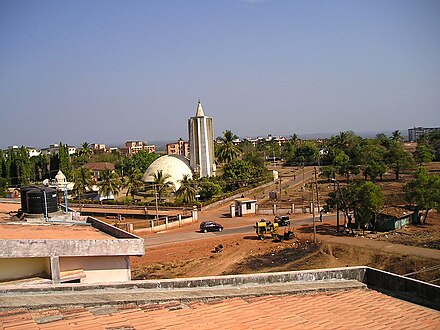
- Amanthrana, Shri Ramakrishna Lodge Building, Opp Githanjali Talkies, Near City Bus Stand, Udupi 576101, 13.3446°, 74.7498°, +91 820-2527352. Vegetarian restaurant famous for North Indian food, but serves South Indian as well
- Thamboolam, Opp Kalpana theatre, 13.3370°, 74.7501°, +91 820-257 2157. This is one of the few non-vegetarian restaurants in Udupi. Try the kori rotti here.
- Woodlands, Dr UR Rao Commercial Complex, Near Adamaru Mutt Guest House, Tenkpet, 13.3393°, 74.7512°, +91 820-252 2807. Another icon of Udupi, this is a vegetarian restaurant best known for South Indian food. Like every other restaurant in Udupi, it also serves North Indian food.
Splurge
- Attil (Attill), Laxmeendra Nagar, 2nd Cross, Udupi-Manipal Road, Manipal, 13.3483°, 74.7778°, +91 820-429 5599, +91 89709 90999. Opened in 2011. It has received rave reviews for its sea-food and chicken dishes.
Drink
It is fair to say that Udupi, being a temple town, is not a great place to have alcoholic drinks, and this sleepy town is not known for a vibrant night life. Manipal, however, is a short hop away from the city centre, famous for its student population, and this is where you go if you want a drink.
You can try the unfermented toddy which is extracted early morning from coconut trees. This can usually be found near the beaches. Be very very careful about the quality and safety, however.
- Cocks n' Mocks, End Point Road, Off SH65, Manipal, 13.3471°, 74.7838°. This bizarrely named "standing" bar serves cocktails and mocktails in addition to other alcoholic drinks (hence the name) You get your drink and food from over the counter at the roadside restaurant and consume them at one of the tables placed on the pavement. There is no seating. Cheap and very popular with the student crowd.
- Dee Tee (Down Town Pub), Bhavani Hotel, Parkala Road (SH65), Eshwarnagar, Manipal (Manipal - Udupi), 13.3553°, 74.7977°, +91 820-257 332. Beautiful place to dine. Has an attached Sports Bar and a lounge. A place with decent crowd where you may party the whole night.
Sleep
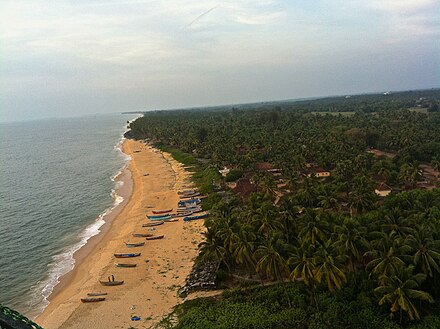 Hotels are reasonably priced and cheap. Most hotels are concentrated around the city centre and the temple. The other option is to look for a hotel near Manipal, which is more expensive. The Paradise Island Beach Resort (see under "Do") is an option if you are looking for a beach holiday.
Hotels are reasonably priced and cheap. Most hotels are concentrated around the city centre and the temple. The other option is to look for a hotel near Manipal, which is more expensive. The Paradise Island Beach Resort (see under "Do") is an option if you are looking for a beach holiday.
- Century Executive, Sanskrit College Road (off Udupi District Bus Stand), 13.3419°, 74.7488°, +91 918202593311. Check-in: noon, check-out: 2PM. ₹1,400+tax
- Fortune Inn Valley View, Madhava Nagar, Manipal, 13.3543°, 74.7906°, +91 820-257 1101. Close to Manipal University. Facilities are good, but the price is way over what you'd expect in Udupi. ₹4,000-10,000
- Kediyoor Hotels (Kidiyoor Hotels), Near Bus Stand, 13.3432°, 74.7467°, +91 820-252-2381, enquiry@kediyoorhotels.com. Check-in: 24 hr, check-out: undefined. ₹850+tax
- Rukmini Residency. Check-in: Any time, check-out: 24 hours. Good, basic hotel close to the Sri Krishna temple and city centre. ₹800
- Sharada International, Bananje, NH66, 13.3495°, 74.7372°, +91 820-252 1968, +91 820-252 2910, hotelshardaintl@gmail.com. Check-in: Any time, check-out: 24 hr. A good, reasonably priced hotel a short distance from the Sri Krishna temple. ₹600-2,500
- Udupi Residency, Near service Bus Stand, 13.3419°, 74.7482°, +91 820-2530005, info@udupiresidency.com. Check-in: Any time, check-out: 24 hr. Centrally air-conditioned, all 33 rooms have a full range of amenities, from attached baths, dining facilities, cable television and Internet access ₹1,400+tax
Go next
To the west of Udupi lies the historic town of Karkala, which is a major religious centre for Jainism. There stands a 42-feet statue of the saint Bahubali (known as Gomateshwara), completely naked, as is the custom. At Moodabidri in Dakshina Kannada district, there is a Jain temple with thousand pillars (saavira kambada basadi).
There are many Hindu religious sites in the neighbourhood of Udupi. At Kollur in Byndoor taluk, there is a famous temple dedicated to the Goddess Mookambika. Further north is Uttara Kannada, home to many nice beaches like the Murudeshwar beach, around 150 km away, and Gokarna beach, around 250 km away. North of Uttara Kannada is Goa, which is around 5 hours by car.
Further north is Uttara Kannada, home to many nice beaches like the Murudeshwar beach, around 150 km away, and Gokarna beach, around 250 km away. North of Uttara Kannada is Goa, which is around 5 hours by car.
Other attractions